November 30, 2009
Dive Bomber
Back in the early days of dive bombing, the British Air Ministry attempted to answer the question "what IS a dive bombing attack?" In their definition, which was generally accepted by the various air forces, when the aircraft drops its bombs while descending at an angle of 20 degrees or less, it was executing a shallow glide bombing attack. From 20 to 60 degrees, it was a steep glide bombing run.
However it was only when the pilot guided his craft into a plummeting descent of between 60 and 90 (also known as 'straight down') degrees that he was performing that most accurate, deadly and dangerous manuever, a dive bombing attack. It was dive bombing that blew open the way for Germany's blitzkrieg across Europe. It was dive bombing that helped pummel Pearl Harbor's facilities and airbases. It was dive bombing that killed HMS Hermes, the first aircraft carrier to be sunk by aircraft. It was dive bombing that sank four Japanese aircraft carriers at Midway. It was (mostly) dive bombing that shut off the flow of supplies to the Japanese soldiers at Guadalcanal. One could go so far as to argue that dive bombing won the naval war in the Pacific.
Yet it was the dive bomber that disappeared from the lineups of the various air forces almost as soon as World War II was over. Why?
*THE PLANES
For all intents and purposes, there were four major planes designated as Dive Bombers in World War II. Oddly, the worst of the bunch is the one that's best remembered and is thought of as the prototypical DB.
The Ju87, better known as the Stuka, was used by Germany as heavy artillery. Luftwaffe liason officers were attached to Wehrmacht units as what we would now call forward air controllers for Close Air Support. The Stuka would be called in to pummel strongpoints with the type of accuracy only available to dive bombers. The Luftwaffe had better designs to chose from when the time came to begin preparing for war but the Stuka had the support of Ernst Udet, who was the Director-General of Equipment. However, it was quite slow when carrying the usual bombload of 1100lbs, maxing out at about 150mph. In comparison to the other planes on this list, it had a very short range of about 300 miles It was also quite unmanueverable and could be hacked out of the air in immense numbers by even small amounts of fighters. When escorted by fighters, however, the Stuka could be very effective. It was able to dive vertically when executing an attack, which was devastating against stationary targets. After the Battle of Britain, where the Stuka's weaknesses were brought to stark light, the plane should have been withdrawn from action. Germany had no choice but to use it throughout the war, in upgraded forms, as there was no replacement. Despite all this, it is images of the Stuka, stooping upon a target with its landing-gear-mounted sirens (called "Jericho's Trumpet" by crews) wailing, that leap to mind when the public thinks of dive bombing.
The Aichi D3A (Allied code name 'Val'), was the primary dive bomber of the Imperial Japanese Navy for most of the Pacific War. A contemporary of the Stuka, it flew slowly enough that drag from the fixed landing gear was not considered an issue. It was rather sturdy for a Japanese warplane, yet manueverable enough to be able to hold its own against fighters when unladen. While it generally could not dive as steeply as the other planes on this list, when combined with the highly experienced pilots of the IJN it was phenomenally accurate. During the Indian Ocean raid at the beginning of 1942, Vals caught the British cruisers Dorsetshire and Cornwall 200 miles off of Ceylon and scored on 85% of their attacks, sinking both ships in minutes. Later, Vals participated in the attack on HMS Hermes, scoring 40 hits from 70 planes. With a maximum speed of 240mph (less with bombload) and a maximum range of 915 miles, it was perfectly suited to naval war in the vast ranges of the Pacific Ocean. Its main weakness was that it could only carry a 551lb bombload, which was marginal against larger vessels.
The Douglas SBD, or Dauntless as it was commonly known, was used by the US Navy and Marines throughout WWII, though it was supplanted by the SB2C Helldiver in 1944. It was never entirely replaced, however. With a top speed of 255mph and a range of 770 miles without a bomb, the Dauntless was also quite nimble, racking up quite a few kills against the Japanese Zero. Early in the war, it was common to see Dauntlesses acting as anti-torpedo-plane interceptors, though this practice stopped when the number of fighters carried by US carriers was increased. It could carry a 1000lb bomb. The Dauntless is credited with singlehandedly sinking six Japanese carriers, including four in one day at the Battle of Midway. When carrying a bombload however, the Dauntless only had a combat radius of about 200 miles or so, fairly short in the Pacific. It was also used by the Army Air Force as the A-24, but was generally unsuccessful, more from a lack of institutional enthusiasm for dive bombing than poor performance.
The Curtiss SB2C Helldiver was the ultimate in dive bombers. Able to carry a ton of bombs (or a torpedo) in an internal bay, it could go nearly 300mph with a maximum range of 1200 miles (unladen). A big plane, it was rather unmanueverable and complex to maintain. After early teething problems were ironed out, though, it became quite a useful bomber, participating in all major actions in the later years of the war in the Pacific. It was never as popular amongst aircrews as the Dauntless, being nicknamed "Beast" or "Son of a Bitch 2nd Class", though later versions of the plane were undoubtably better in every way than the smaller SBD. Due to a lack of targets, the Helldiver didn't ring up a large kill total of ships, though they were instrumental in the sinking of the Yamato and Mushashi, the IJN superbattleships.
Other dive bombers in World War II included the British Blackburn Skua, the Soviet Pe-2 and IL-2, the Vought SB2U Vindicator, the German Ju88 and the Japanese Yokosuka D4Y Suisei, which was the only plane that could argue the SB2C's title as "best dive bomber."
*THE TACTICS
Dive bombing was much more than just "point yourself at the target and dive".
A dive bomber would approach a target from around 10-15000 feet altitude, dropping in shallow dive down to about 5000-7000 feet. Upon reaching the push-over point, a dive bomber would throttle back to about 50% maximum power, extend their dive brakes, and begin a steep dive down to around 1000 feet. Each plane would reach a different high speed during this dive (the Stuka would hit around 350mph, while the Dauntless would hover around 240mph). Upon reaching its release altitude (again, around 1000 feet), a pilot would retract his dive brakes, increase throttle and pull up steeply at around 5g. Again, depending on the plane and the bravery of the pilot, the altitude would bottom out around 500 feet or less as the dive bomber rapidly exited the area.
Against an immobile target, a squadron of dive bombers would approach and dive from different directions so as to confuse the defending antiaircraft guns. As always, however, coming out of the sun was usually the preferred method of attack, so as to limit the defender's visibility.
Against a ship, however, the rules were different. In a perfect setup, a squadron would dive heading upwind and in the direction of the ship's travel (heading from stern to bow, in other words). The planes would all attack from the same direction, one after the other, in line astern. A vigorously manuevering target, however, did cause some headaches for a pilot. He would have to change the attitude of his plane to follow the ship's path, all the while hanging against his seatbelt/harness.
Early in the war, particularly for the Japanese, it was nearly impossible to shoot down a dive bomber after it began its dive with anti-aircraft guns. Early gun directors could not deal with a plane moving at high speed and shedding appalling amounts of altitude in a short time, making a plunging dive bomber nearly invunerable. Indeed, during the Battle of Midway, Japanese AA managed to shoot down only one Dauntless. The best defense against a dive bomber at this time was to shoot it down during its approach, usually with a fighter.
*THE END OF A WEAPON
It was improvements in anti-aircraft fire that spelled the end of the dive bomber, however.
By the end of the war, it was practically suicidal for any dive bomber to approach an American ship. More (and better) AA guns, under radar direction, using proximity fuzes, could blow any plane out of the air at long ranges. It was bad enough for a torpedo plane, having to fly in a straight line at a relatively low speed, but at least they could stay a good distance away from their target and still release their weapon. For a dive bomber, however, which basically had to overfly its target, they were sitting ducks. By the end of the war, a Japanese naval vessel, which never carried a particularly large number of AA guns even under the best of circumstances, could expect that it would have the number of AA guns doubled or tripled from what it had carried at the beginning of the war.
And though the Axis powers never developed the proximity fuze for their AA guns, when you're putting enough bullets in the air you often didn't need them. German anti-aircraft guns were fearsome indeed, which is one of the reasons the Allies didn't use dive bombers much in Europe. Indeed, the RAF and FAA, who are often credited with creating and formalizing the concept of dive bombing, never had more than a couple of squadrons of dive bombers at any time during WWII. This despite the benefits of the type being on display against them in Poland, Belgium and France. The reason given was that it would be too costly in men and machines, and it's hard to debate the point.
Another reason for the disappearance of the dive bomber was the rise of what is now called the multi-role aircraft. The F4U Corsair, for example, could perform steep diving attacks nearly as well as the Dauntless despite the lack of dive brakes, had a longer range, and could carry a greater weight of bombs to boot. The P-47 Thunderbolt was another excellent fighter that could double as an attack plane, as was the Focke-Wulf Fw190. Using a fighter to do a bomber's job, and perhaps do it better to boot, made a lot of sense, particularly in the crowded hangar decks of an aircraft carrier.
The massacre of a squadron of dive bombers by such technology as a surface-to-air missile could easily be imagined, but by that time the dive bomber was no more.
*EPILOGUE
The dive bomber, in some ways, still lives on today. It's not hard to see modern precision guided munitions (or "smart bombs") as the direct descendant of the bombs dropped by Stukas, Dauntlesses and Vals. To continue the analogy, the air-dropped torpedo became the stand-off missile (such as the Tomahawk cruise missile or Harpoon anti-shipping weapon).
However you look at it though, today's attack pilot still needs to do the same thing as the dive bomber: put a bomb on a relatively small target with skill and precision.
This post is dedicated to Mort Price, USMC, Dauntless rear-seat gunner.
However it was only when the pilot guided his craft into a plummeting descent of between 60 and 90 (also known as 'straight down') degrees that he was performing that most accurate, deadly and dangerous manuever, a dive bombing attack. It was dive bombing that blew open the way for Germany's blitzkrieg across Europe. It was dive bombing that helped pummel Pearl Harbor's facilities and airbases. It was dive bombing that killed HMS Hermes, the first aircraft carrier to be sunk by aircraft. It was dive bombing that sank four Japanese aircraft carriers at Midway. It was (mostly) dive bombing that shut off the flow of supplies to the Japanese soldiers at Guadalcanal. One could go so far as to argue that dive bombing won the naval war in the Pacific.
Yet it was the dive bomber that disappeared from the lineups of the various air forces almost as soon as World War II was over. Why?
*THE PLANES
For all intents and purposes, there were four major planes designated as Dive Bombers in World War II. Oddly, the worst of the bunch is the one that's best remembered and is thought of as the prototypical DB.
The Ju87, better known as the Stuka, was used by Germany as heavy artillery. Luftwaffe liason officers were attached to Wehrmacht units as what we would now call forward air controllers for Close Air Support. The Stuka would be called in to pummel strongpoints with the type of accuracy only available to dive bombers. The Luftwaffe had better designs to chose from when the time came to begin preparing for war but the Stuka had the support of Ernst Udet, who was the Director-General of Equipment. However, it was quite slow when carrying the usual bombload of 1100lbs, maxing out at about 150mph. In comparison to the other planes on this list, it had a very short range of about 300 miles It was also quite unmanueverable and could be hacked out of the air in immense numbers by even small amounts of fighters. When escorted by fighters, however, the Stuka could be very effective. It was able to dive vertically when executing an attack, which was devastating against stationary targets. After the Battle of Britain, where the Stuka's weaknesses were brought to stark light, the plane should have been withdrawn from action. Germany had no choice but to use it throughout the war, in upgraded forms, as there was no replacement. Despite all this, it is images of the Stuka, stooping upon a target with its landing-gear-mounted sirens (called "Jericho's Trumpet" by crews) wailing, that leap to mind when the public thinks of dive bombing.
The Aichi D3A (Allied code name 'Val'), was the primary dive bomber of the Imperial Japanese Navy for most of the Pacific War. A contemporary of the Stuka, it flew slowly enough that drag from the fixed landing gear was not considered an issue. It was rather sturdy for a Japanese warplane, yet manueverable enough to be able to hold its own against fighters when unladen. While it generally could not dive as steeply as the other planes on this list, when combined with the highly experienced pilots of the IJN it was phenomenally accurate. During the Indian Ocean raid at the beginning of 1942, Vals caught the British cruisers Dorsetshire and Cornwall 200 miles off of Ceylon and scored on 85% of their attacks, sinking both ships in minutes. Later, Vals participated in the attack on HMS Hermes, scoring 40 hits from 70 planes. With a maximum speed of 240mph (less with bombload) and a maximum range of 915 miles, it was perfectly suited to naval war in the vast ranges of the Pacific Ocean. Its main weakness was that it could only carry a 551lb bombload, which was marginal against larger vessels.
The Douglas SBD, or Dauntless as it was commonly known, was used by the US Navy and Marines throughout WWII, though it was supplanted by the SB2C Helldiver in 1944. It was never entirely replaced, however. With a top speed of 255mph and a range of 770 miles without a bomb, the Dauntless was also quite nimble, racking up quite a few kills against the Japanese Zero. Early in the war, it was common to see Dauntlesses acting as anti-torpedo-plane interceptors, though this practice stopped when the number of fighters carried by US carriers was increased. It could carry a 1000lb bomb. The Dauntless is credited with singlehandedly sinking six Japanese carriers, including four in one day at the Battle of Midway. When carrying a bombload however, the Dauntless only had a combat radius of about 200 miles or so, fairly short in the Pacific. It was also used by the Army Air Force as the A-24, but was generally unsuccessful, more from a lack of institutional enthusiasm for dive bombing than poor performance.
The Curtiss SB2C Helldiver was the ultimate in dive bombers. Able to carry a ton of bombs (or a torpedo) in an internal bay, it could go nearly 300mph with a maximum range of 1200 miles (unladen). A big plane, it was rather unmanueverable and complex to maintain. After early teething problems were ironed out, though, it became quite a useful bomber, participating in all major actions in the later years of the war in the Pacific. It was never as popular amongst aircrews as the Dauntless, being nicknamed "Beast" or "Son of a Bitch 2nd Class", though later versions of the plane were undoubtably better in every way than the smaller SBD. Due to a lack of targets, the Helldiver didn't ring up a large kill total of ships, though they were instrumental in the sinking of the Yamato and Mushashi, the IJN superbattleships.
Other dive bombers in World War II included the British Blackburn Skua, the Soviet Pe-2 and IL-2, the Vought SB2U Vindicator, the German Ju88 and the Japanese Yokosuka D4Y Suisei, which was the only plane that could argue the SB2C's title as "best dive bomber."
*THE TACTICS
Dive bombing was much more than just "point yourself at the target and dive".
A dive bomber would approach a target from around 10-15000 feet altitude, dropping in shallow dive down to about 5000-7000 feet. Upon reaching the push-over point, a dive bomber would throttle back to about 50% maximum power, extend their dive brakes, and begin a steep dive down to around 1000 feet. Each plane would reach a different high speed during this dive (the Stuka would hit around 350mph, while the Dauntless would hover around 240mph). Upon reaching its release altitude (again, around 1000 feet), a pilot would retract his dive brakes, increase throttle and pull up steeply at around 5g. Again, depending on the plane and the bravery of the pilot, the altitude would bottom out around 500 feet or less as the dive bomber rapidly exited the area.
Against an immobile target, a squadron of dive bombers would approach and dive from different directions so as to confuse the defending antiaircraft guns. As always, however, coming out of the sun was usually the preferred method of attack, so as to limit the defender's visibility.
Against a ship, however, the rules were different. In a perfect setup, a squadron would dive heading upwind and in the direction of the ship's travel (heading from stern to bow, in other words). The planes would all attack from the same direction, one after the other, in line astern. A vigorously manuevering target, however, did cause some headaches for a pilot. He would have to change the attitude of his plane to follow the ship's path, all the while hanging against his seatbelt/harness.
Early in the war, particularly for the Japanese, it was nearly impossible to shoot down a dive bomber after it began its dive with anti-aircraft guns. Early gun directors could not deal with a plane moving at high speed and shedding appalling amounts of altitude in a short time, making a plunging dive bomber nearly invunerable. Indeed, during the Battle of Midway, Japanese AA managed to shoot down only one Dauntless. The best defense against a dive bomber at this time was to shoot it down during its approach, usually with a fighter.
*THE END OF A WEAPON
It was improvements in anti-aircraft fire that spelled the end of the dive bomber, however.
By the end of the war, it was practically suicidal for any dive bomber to approach an American ship. More (and better) AA guns, under radar direction, using proximity fuzes, could blow any plane out of the air at long ranges. It was bad enough for a torpedo plane, having to fly in a straight line at a relatively low speed, but at least they could stay a good distance away from their target and still release their weapon. For a dive bomber, however, which basically had to overfly its target, they were sitting ducks. By the end of the war, a Japanese naval vessel, which never carried a particularly large number of AA guns even under the best of circumstances, could expect that it would have the number of AA guns doubled or tripled from what it had carried at the beginning of the war.
And though the Axis powers never developed the proximity fuze for their AA guns, when you're putting enough bullets in the air you often didn't need them. German anti-aircraft guns were fearsome indeed, which is one of the reasons the Allies didn't use dive bombers much in Europe. Indeed, the RAF and FAA, who are often credited with creating and formalizing the concept of dive bombing, never had more than a couple of squadrons of dive bombers at any time during WWII. This despite the benefits of the type being on display against them in Poland, Belgium and France. The reason given was that it would be too costly in men and machines, and it's hard to debate the point.
Another reason for the disappearance of the dive bomber was the rise of what is now called the multi-role aircraft. The F4U Corsair, for example, could perform steep diving attacks nearly as well as the Dauntless despite the lack of dive brakes, had a longer range, and could carry a greater weight of bombs to boot. The P-47 Thunderbolt was another excellent fighter that could double as an attack plane, as was the Focke-Wulf Fw190. Using a fighter to do a bomber's job, and perhaps do it better to boot, made a lot of sense, particularly in the crowded hangar decks of an aircraft carrier.
The massacre of a squadron of dive bombers by such technology as a surface-to-air missile could easily be imagined, but by that time the dive bomber was no more.
*EPILOGUE
The dive bomber, in some ways, still lives on today. It's not hard to see modern precision guided munitions (or "smart bombs") as the direct descendant of the bombs dropped by Stukas, Dauntlesses and Vals. To continue the analogy, the air-dropped torpedo became the stand-off missile (such as the Tomahawk cruise missile or Harpoon anti-shipping weapon).
However you look at it though, today's attack pilot still needs to do the same thing as the dive bomber: put a bomb on a relatively small target with skill and precision.
This post is dedicated to Mort Price, USMC, Dauntless rear-seat gunner.
Posted by: Wonderduck at
10:39 PM
| Comments (7)
| Add Comment
Post contains 1962 words, total size 13 kb.
November 23, 2009
The Japanese "Saving Private Ryan"
Otoko Tachi no Yamato, or "The Men of Yamato" in English, tells the story of the final sortie of that famed battleship. Not from a strategic standpoint, mind, but from that of her men. The script isn't brilliant, but you do know and care about these sailors by the time the American carrier planes begin to appear as the battleship approaches Okinawa.
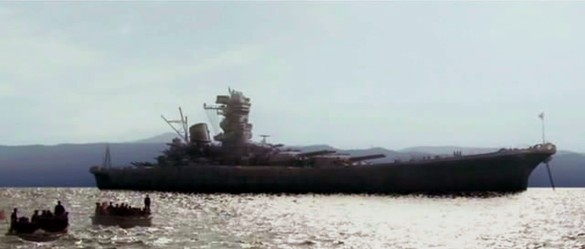
But the main character in this movie is the Yamato herself. No expense was spared in the making of this epic film, including a 1:1 scale set of the forward section of the ship, and the port side of the island area (the anti-aircraft guns in particular) that cost ¥600 million (nearly $7million).
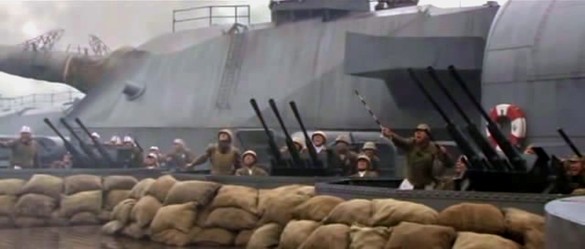
While the producers did wind up reusing a lot of the CG footage in the two major battle scenes, it's barely noticeable amidst all the chaos of war. And make no mistake, this movie pulls no punches when it comes to the combat... if you can't stand the sight of blood, this is not the movie for you.
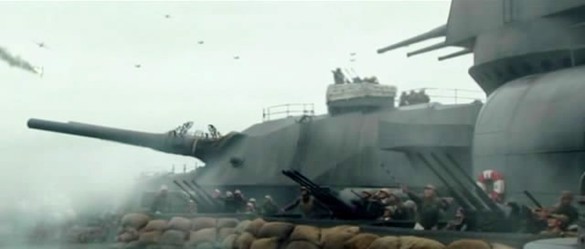
If you can stomach seeing people opened up by machine-gun rounds and the deck running red with blood, however, what you'll get is a war movie that ranks up near the top of the list. It's not as good as Saving Private Ryan or the HBO miniseries Band of Brothers, true, but it's lightyears ahead of, say, Tora Tora Tora or Midway.
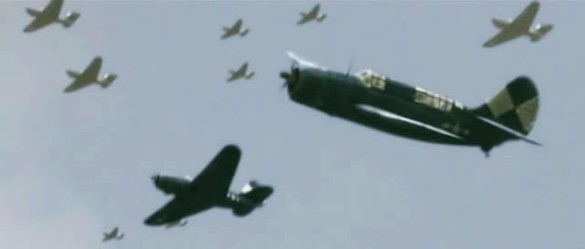
While this screencap makes it look obvious that we're looking at models or CG, in motion it's nearly flawless. The amount of detail is immense, both in the planes and in the Yamato herself.
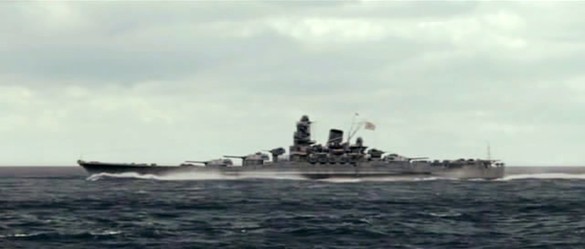
But when the final attack begins, the great ship goes to hell in a hurry. You barely notice that the whole fight is nearly 30 minutes long.
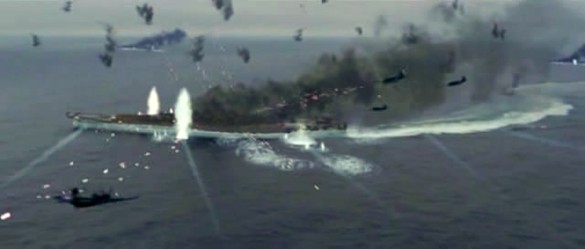
The sailors aren't supermen. There's no "one man shooting down a squadron", or even a single plane, like you might see in an American war movie. They're just there to serve the guns, and die. And die they do, in droves.
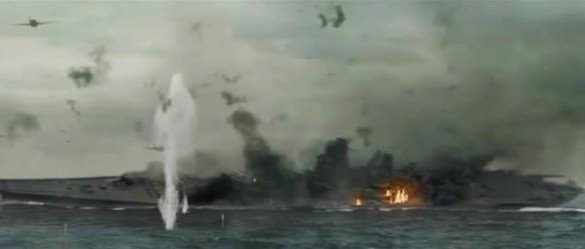
If you can find a copy of the movie, I recommend it heartily. It's well-done, historically accurate, and beautifully shot. You get the feeling that you're watching a documentary on the shipboard life of the Yamato, rather than a feature film, but it's never dull, despite the 2-1/2 hour length.
It's not perfect, but it's plenty good, and a fitting tribute to the men who crewed her.
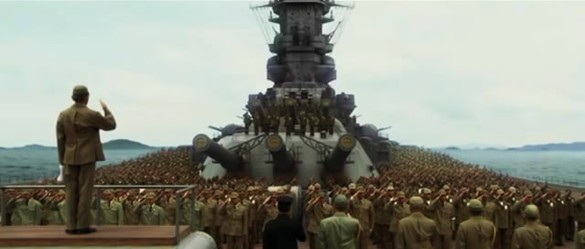

But the main character in this movie is the Yamato herself. No expense was spared in the making of this epic film, including a 1:1 scale set of the forward section of the ship, and the port side of the island area (the anti-aircraft guns in particular) that cost ¥600 million (nearly $7million).

While the producers did wind up reusing a lot of the CG footage in the two major battle scenes, it's barely noticeable amidst all the chaos of war. And make no mistake, this movie pulls no punches when it comes to the combat... if you can't stand the sight of blood, this is not the movie for you.

If you can stomach seeing people opened up by machine-gun rounds and the deck running red with blood, however, what you'll get is a war movie that ranks up near the top of the list. It's not as good as Saving Private Ryan or the HBO miniseries Band of Brothers, true, but it's lightyears ahead of, say, Tora Tora Tora or Midway.

While this screencap makes it look obvious that we're looking at models or CG, in motion it's nearly flawless. The amount of detail is immense, both in the planes and in the Yamato herself.

But when the final attack begins, the great ship goes to hell in a hurry. You barely notice that the whole fight is nearly 30 minutes long.

The sailors aren't supermen. There's no "one man shooting down a squadron", or even a single plane, like you might see in an American war movie. They're just there to serve the guns, and die. And die they do, in droves.

If you can find a copy of the movie, I recommend it heartily. It's well-done, historically accurate, and beautifully shot. You get the feeling that you're watching a documentary on the shipboard life of the Yamato, rather than a feature film, but it's never dull, despite the 2-1/2 hour length.
It's not perfect, but it's plenty good, and a fitting tribute to the men who crewed her.

Posted by: Wonderduck at
09:51 PM
| Comments (7)
| Add Comment
Post contains 409 words, total size 3 kb.
November 06, 2009
Remember That Torpedo 8 Detachment?
The first combat experience of the Grumman TBF (latter named the Avenger) came at the Battle of Midway, with a detachment of planes from Torpedo 8. We all know how that turned out: five TBFs shot down, and the sixth a flying sieve.
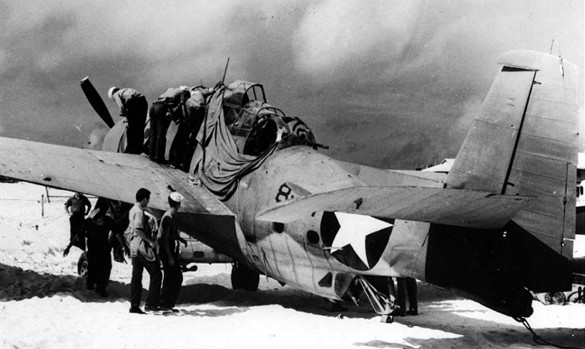
The pilot of the surviving TBF was Ensign Bert Earnest. He later went on to fight with VT-8 at Guadalcanal. He retired from the Navy as a Captain. Along the way, he earned a Purple Heart, two Air Medals, and three Navy Crosses.
Albert K Earnest, CAPT USN (RET) passed away on October 26th at the age of 92.
May he rest in peace.

The pilot of the surviving TBF was Ensign Bert Earnest. He later went on to fight with VT-8 at Guadalcanal. He retired from the Navy as a Captain. Along the way, he earned a Purple Heart, two Air Medals, and three Navy Crosses.
Albert K Earnest, CAPT USN (RET) passed away on October 26th at the age of 92.
May he rest in peace.
Posted by: Wonderduck at
06:23 PM
| Comments (15)
| Add Comment
Post contains 112 words, total size 1 kb.
<< Page 1 of 1 >>
59kb generated in CPU 0.0218, elapsed 0.1783 seconds.
47 queries taking 0.1652 seconds, 192 records returned.
Powered by Minx 1.1.6c-pink.
47 queries taking 0.1652 seconds, 192 records returned.
Powered by Minx 1.1.6c-pink.









